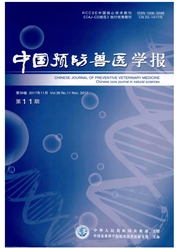

 中文摘要:
中文摘要:
为研究旋毛虫感染对小鼠肌肉卫星细胞中Toll样受体3(TLR3)以及程序性死亡配体(B7-H1)表达的影响,本研究采用灌胃感染小鼠,以Percoll分离、差速贴壁法及Desmin免疫细胞化学染色,从小鼠后肢骨骼肌中分离并鉴定肌肉卫星细胞,经流式细胞术检测旋毛虫感染的肌肉卫星细胞。结果表明,B7-H1平均荧光强度与空白对照组相比统计学差异显著(p〈0.01)。荧光定量PCR检测显示旋毛虫感染后TLR3 mRNA与对照组相比表达量显著增加(p〈0.01)。本研究为进一步了解旋毛虫治疗自主免疫病的机制及研究旋毛虫感染后如何引发抗病毒免疫作用提供了实验依据。
 英文摘要:
英文摘要:
To study the effect on TLR3 and B7-H1 expression in mouse muscle satellite cells stimulated by Trichinella infection, the muscle satellite cells from hind limb skeletal muscle of mice infected with Trichinella spiralis were isolated and identified by percoll, differential adherence and desmin immtmocytochemistry. The flow cytometry analysis revealed that the mean fluorescence intensity of the infected and non-infected mice existed the statistical difference and the B7-H1 expression was significant upregnlated in cells of the infected mice. In addition, Real-time RT-PCR assay verified the TLR3 mRNA expression level was also significantly increased in the cell of the infected mice. These results of the study would contribute to the treatment of autoimmune disease by T.spiralis and referenced to anti-viral immunity mechanism induced by Trichinella infection.
 同期刊论文项目
同期刊论文项目
 同项目期刊论文
同项目期刊论文
 Transcriptome of Small Regulatory RNAs in the Development of the Zoonotic Parasite Trichinella spira
Transcriptome of Small Regulatory RNAs in the Development of the Zoonotic Parasite Trichinella spira An anti-tumor protein produced by Trichinella spiralis induces apoptosis in human hepatoma H7402 cel
An anti-tumor protein produced by Trichinella spiralis induces apoptosis in human hepatoma H7402 cel Global Gene Expression Analysis of the Zoonotic Parasite Trichinella spiralis Revealed Novel Genes i
Global Gene Expression Analysis of the Zoonotic Parasite Trichinella spiralis Revealed Novel Genes i Toll-like receptor activation by helminths or helminth products to alleviate inflammatory bowel dise
Toll-like receptor activation by helminths or helminth products to alleviate inflammatory bowel dise 期刊信息
期刊信息
